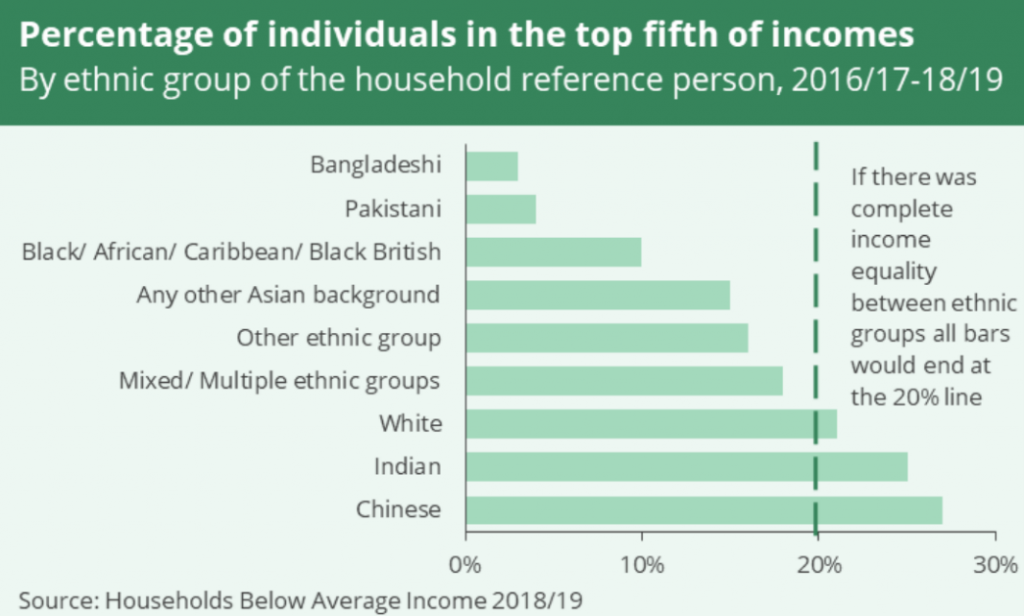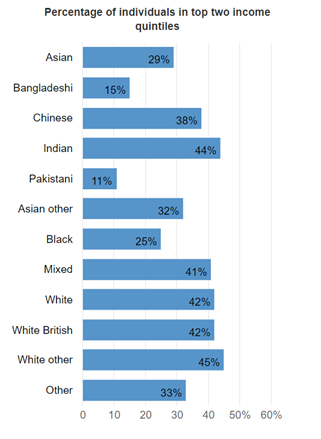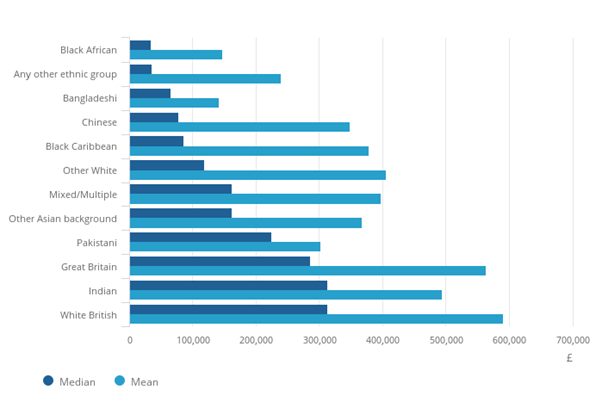The acronym BAME lumps together black, Asian and minority ethnic groups as disadvantaged. Yet not all these groups and certainly not all individuals within them can be characterised as disadvantaged. There are better methods for identifying disadvantaged communities and designing appropriate policy.
One of the recommendations in the recent report of the Commission of Race and Ethnic Disparities (the Sewell report) is to discontinue the use of the term BAME (black, Asian and minority ethnic) as a catch-all to describe ethnic groups who are disadvantaged in the UK. It was introduced as a collective term in the 1960s and 1970s for administrative convenience to identify ‘black communities’ and was eventually expanded to encompass other, mostly non-white, ethnic minorities.
The term has received a lot of criticism in recent years, both for including groups whose members feel that they do not belong to this classification, and for leaving out several white British minorities, such as the Cornish, Welsh, Scottish and Northern Irish.
At the very least, the term irks members of groups who feel that a meaningless identity has been imposed on them without their consent. At the extreme, the term can be viewed as one that amplifies a racial divide between whites and non-whites. In addition, its usage in common parlance suggests that being in an ethnic minority group implies disadvantage, despite the lack of evidence to support such an assumption.
What do disadvantaged Britons look like?
The use of the term BAME in recent times has been all about describing economic and social disadvantage. But looking at current statistics for the UK’s income distribution by ethnic group shows that the picture is more nuanced.
According to recent statistics, British Chinese have the highest incomes of all ethnic groups, followed by Indians and whites. By contrast, British Bangladeshis, Pakistanis and black/Caribbean/African and black British are least represented in the top 20% of all income earners.
The findings are reversed when we examine the bottom 40%, where British Bangladeshis, Pakistanis and black/Caribbean/African and black British are disproportionately represented. Thus, not all British ethnic minorities are disadvantaged. Likewise, there is a large proportion of the British poor who are white.
Figure 1: Percentage of individuals in the top fifth of incomes before housing costs, by ethnicity

Source: Households below average income 2018-19, Office for National Statistics
Figure 2: Percentage of households in the top two income quintiles (before housing costs), by ethnicity

Source: Office for National Statistics
Wealth inequality in the UK has yet another harsh story to tell. While the median white British and Indian household in the last decade was worth £282,000 and £266,000, respectively, the median black Caribbean household only owned £89,000 of assets. Black African and Bangladeshi households had the lowest household net worth at just £24,000 and £22,000, respectively.
These wealth inequality statistics are partly explained by age (as the white British and Indian households are older), but they are also a consequence of historical inequalities in education and access to good jobs. Lower incomes mean lower saving rates and thus fewer assets.
Recent studies also show that the role of inherited wealth in determining individuals’ life outcomes has become increasingly important for those born from the 1960s onwards. As Figure 3 shows, the distribution of wealth in the UK is highly unequal: British whites and Indians have the highest amounts of wealth, while black Africans and Bangladeshis have the least.
Figure 3: Average total household wealth by ethnicity of the household head, April 2016 to March 2018

Source: Office for National Statistics
The share of disadvantaged households in the UK also varies greatly by region. The majority of ethnic minority poverty is concentrated in inner-city London, where three-fifths of black Britons live. Yet outside London, the distribution of the ethnically disadvantaged is similar to that of disadvantaged whites across the UK. Ethnic variation in poverty is remarkably less pronounced outside London.
Thus, while not all ethnic minorities are disadvantaged as the umbrella term can imply, there are still drastic inequalities in income and wealth across groups. The UK’s disadvantaged ethnic groups deserve outstanding attention due to the stark inequalities in income and wealth.
But by categorising all ethnic minority groups together, we miss out crucial information about their specific vulnerabilities. For example, within the British black community, women may be more likely to be disadvantaged compared with men. Similarly, there may be particular vulnerabilities that are found among Pakistani and Bangladeshi women, but apply less to black women.
These precise details are crucial for designing policies that are effective for specific vulnerable groups, but they are not available to policy-makers when all ethnic minorities are lumped into one group.
How should we identify disadvantaged ethnic groups without using the term BAME?
For almost two centuries, social scientists and policy-makers in the UK have been measuring poverty and levels of disadvantage by social groups, using both survey and national statistics.
Some of the earliest documentation of poverty in the UK was commissioned by Queen Victoria for Benjamin Disraeli’s government on the occupational groups of the poor (Benjamin Disraeli’s correspondence with Queen Victoria, 1882). Nineteenth-century reports on poverty and deprivation in British colonies also document deprivation by economic and social groups (Lord Ripon’s (1882) and Lord Dufferin’s (1885) letters to the Secretary of State for India, on the conditions of the poor in British India, National Archives).
Economists today use a rich body of measures of poverty and vulnerability to identify deprivation according to different demographic and social groups. These range from simple metrics from ‘headcount’ measures, which estimate the proportion of the population living under a poverty line (which is a pre-defined level of income – currently at 60% of the UK’s median income), to highly complex definitions of multi-dimensional poverty, where deprivation is collectively measured using metrics such as incomes or expenditure, education and health.
These can all specifically identify sub-groups of the poor. The list of measures and methods one can use to count the disadvantaged by social groups or by several dimensions of deprivation is almost endless (Alkire et al, 2020).
Likewise, the economics profession has developed a wide range of metrics to measure inequality, including between and within ethnic groups. Modern econometric methods independent of poverty and inequality measurement, using experimental techniques or regression-based methods, can also identify disadvantage by social groups. The list of approaches and methods is thus ever growing.
The Deaton review (2020), which has measured the unequal impact of Covid-19 on ethnic minorities in the UK sets a fine example of how policy-makers can identify and design policies for the specific ethnic minority groups that are disadvantaged by economic downturns.
Should BAME be replaced by another acronym or term?
As discussed thus far, there is no clear economic or social reason to group a selection of ethnic minority communities with the objective of identifying levels of economic disadvantage. Indeed, there will continue to be specific ethnic communities, such as the Bangladeshi, Pakistani and Afro-Caribbean communities, that deserve special attention to ensure basic socio-economic necessities are met, including health, education and employment.
While a catch-all term can appear useful for capturing issues affecting groups of people, they can mask other differences or specific issues. It may be more effective therefore to refer to these groups simply by their existing names. Analysing the causes and sources of the lack of opportunities for these groups is more valuable than using a catch-all term. Most importantly, it contributes little to help devising policies that support the most disadvantaged groups or individuals.
A further downside of acronyms – such as BAME – is that the UK’s disadvantaged ethnic groups are likely to change over time. Afro-Caribbean/African, Pakistani and Bangladeshi communities may cease to be economically disadvantaged in the future, and others may take their place.
Existing economic tools and policy mechanisms can be effective to improve the condition of disadvantaged ethnic groups. We should turn our attention to ensuring that governments implement incisive methods for reaching specific disadvantaged communities quickly. Terms that mask differences between heterogeneous groups can be counterproductive. It is important to remember that not all Afro-Caribbeans, Pakistanis and Bangladeshis are poor or disadvantaged, just as not all whites, Indians and Chinese are rich.
Where can I find out more?
- The IFS Deaton Report, 2020: A review of the inequalities in education, skills and incomes in the UK as a result of the Covid-19 pandemic.
- Multidimensional Poverty Measurement and Analysis: Survey of methods used to measure poverty across a range of metrics.
- Poverty among ethnic groups how and why does it differ? Joseph Rowntree Foundation report by Peter Kenway and Guy Palmer.
- Economics and poverty: Survey of methods about how to measure poverty.
- Poverty in the UK: Statistics – House of Commons report on the current statistics of poverty in the UK
Who are experts on this question?
- Sanghamitra Bandyopadhyay, Queen Mary University of London
- Sabina Alkire, University of Oxford
- Frank Cowell, London School of Economics
- Martin Ravallion, Georgetown University









































